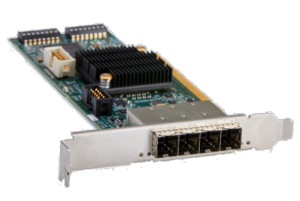GigaIO Gets $14.7M in Series B Funding to Expand Its Composable Fabric Technology to Customers

Just before the COVID-19 pandemic began in March 2020, GigaIO introduced its Universal Composable Fabric technology, which allows enterprises to bring together any HPC and AI resources and integrate them with networking, storage, memory and specialized accelerators into a single-system cluster fabric.
And while installations of its fabric, called FabreX, stalled a bit at the time because enterprises were shut down and few workers were around to complete installations and integrations, things have been picking up in 2021 for the company, which was incorporated in 2012.
GigaIO has just secured $14.7 million in its latest Series B funding round, which was led by Impact Venture Capital and oversubscribed by 50 percent. Other investors included Mark IV Capital, Lagomaj Capital, SK Hynix and Four Palms Ventures.
The new cash, which was announced Sept. 16 (Thursday) brings the company’s total monies from investors to $22.5 million after three rounds of funding. The latest money will be used to expand its marketing, sales and channel development efforts. GigaIO’s first products were launched in 2019.
“It is really good news to see the level of interest,” Alan Benjamin, the president and CEO of GigaIO, told EnterpriseAI. “We introduced product right before COVID-19 … and we start shipping equipment and it is sitting on receiving docks, even if it makes it inside the building because nobody was there.”
Eventually, after the shipments languished for a while, technology workers did begin returning to work and getting their projects underway, he said.
“At the end of last year, people started filling back in, and they started putting together the equipment, they started running their tests,” said Benjamin. “And we had a whole string of people that gave us really positive comments coming back.”
In the first half of 2021, GigaIO has experienced record market activity from quotes to sales shipments and more, he said. “It all came together nicely for this financing round, and people got really interested.”
The reason for the growth, he said, is that the company has struck a chord with customers who are looking to make changes in their data centers to move away from servers and focus on racks.
“It is driven by a whole set of notions [including that] the amount of data your people are collecting has ballooned, and you have to have a vast amount of storage because it doesn't fit in a server anymore,” said Benjamin. “It is starting to happen now with accelerators. So, people want access to either more accelerators, or a larger variety of accelerators, and they simply do not fit inside of a server any longer.”
GigaIO’s FabreX is an enterprise-class, universal composable fabric that is built on open standards. At its core, it is designed to help enterprises get faster results running their mission-critical workloads. The technology gathers compute and network resources from multiple servers and shows them to users as if they were all within one server – all communicating through one seamless universal fabric, according to the company.
The technology uses PCIe cards that are installed in servers, along with special switches and the company’s software, said Benjamin.
“We are effectively exposing the PCI route complex on the server out to our switch … [which is] … running a variety of software that effectively turns the entire rack into one giant PCIe root complex,” he said.
Customers can run it all with GPUs, FPGAs or whatever they choose to use with its existing PCIe Gen 4 interface. In the future, it will also be usable with PCIe Gen 5 and CXL when they are ready for the marketplace.
“And very soon, the same thing is going to happen with memory,” said Benjamin. Existing on-premises networks have been too slow, so users turned to the cloud to try to find answers, but there have been concerns about costs, security and compliance, he said.
What those users want are on-premises systems that offer flexibility, high performance and easy configurability, he said.
 “What users consistently told us is they will not give up on the desire for having on-premises, but they've gotten really comfortable with the notion of the flexibility that they can get with the cloud,” said Benjamin. “And they simply do not want to return to a fixed infrastructure that they have trouble reconfiguring. They want to move to a rack-level construct and that is what fabric does. It is a universal fabric connection that enables them now to be able to put systems together and recompose them at will. And so, it is not just the hardware. It is the hardware, and it is the full level of software.”
“What users consistently told us is they will not give up on the desire for having on-premises, but they've gotten really comfortable with the notion of the flexibility that they can get with the cloud,” said Benjamin. “And they simply do not want to return to a fixed infrastructure that they have trouble reconfiguring. They want to move to a rack-level construct and that is what fabric does. It is a universal fabric connection that enables them now to be able to put systems together and recompose them at will. And so, it is not just the hardware. It is the hardware, and it is the full level of software.”
In the world of HPC, not every user wants to go to GPUs, he said. Some want FPGAs, others want combinations of components.
“People want to get their hands on a large variety of HPC accelerators,” he said. “Not everything is best solved with an [Nvidia] A100. Even if you [can spend] the $12,000 to buy an A100, there are other cases where they want FPGAs, or they want Tensor Cores, or they want an AI-type product, and fabrics today work really well to give them a full slate of accelerators.”
GigaIO is Looking to the Future: Analyst
Ashish Nadkarni, an IT analyst with IDC, told EnterpriseAI that GigaIO’s strategy with its latest funding round and with its products is to be forward looking, especially because its path is headed toward a time when future, advanced PCIe 6 technologies like CXL become mainstream. CXL is an ultra-low latency, ultra-high bandwidth fabric that will further help to disaggregate hardware and even do the same for memory, he said.
“Disaggregation is the process of decoupling everything that has been tightly coupled up until now because of a 30-year- old CPU centric-model,” said Nadkarni. “So, in this 30-year-old architecture, the CPU has exclusive rights to the memory pools. And what that does is, it means that other silicon systems or silicon subsystems in the compute are no longer able to access that memory pool without going through the CPU. With CXL, it is like building an eight-lane highway that enables free access amongst different peripherals CPUs silicon and memory.”
And when CXL is ready, GigaIO will be in a good spot in the marketplace, he said.
“Every company is at a different stage of their vision and strategy,” said Nadkarni. “The way I look at GigaIO is that they are not front-loading their investments. Their investments will take off once certain things start to pan out, like when CXL becomes available. It is creating a vision and strategy in advance of a certain technology becoming generally available and then having a front-row seat when that becomes mainstream. These guys are laying the groundwork for what is to come.”













